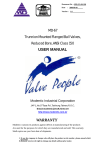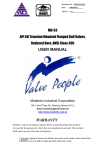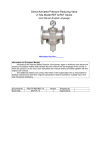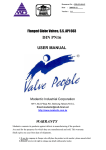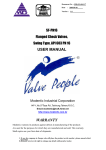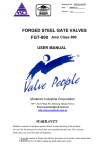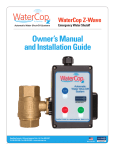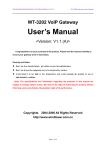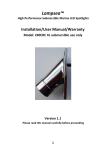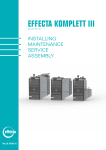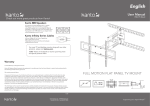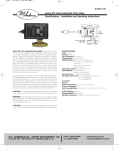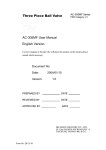Download MD-955TC-ATEX User manual
Transcript
Document No. : MD-QO-04-113 Date : Version : 2009/09/10 1.0 MD-955TC 3 Piece High Purity Ball Valves, Tube Bore, Tri-Clamp USER MANUAL Modentic Industrial Corporation 14F-1,No.57Taya Rd.,Taichung,Taiwan,R.O.C. Email:[email protected] http://www.modentic.com.tw WARRANTY Modentic warrants its products against defects in manufacturing if the products Are used for the purposes for which they are manufactured and sold. This warranty Shall expire one year from date of shipments. 1. To use for company in Europe who will place the product on the market , please amend which necessary. 2.Modentic reserves the right to change any details without prior notice. Contents 1. General Precautions 2. General Description of Product 3. Pressure-Temperature Ratings 4. Delivery Condition and Storage 5. Installation and Operation 6. Put into service 7. Dangers of inappropriate use 8. Maintenance 9. Corrosion Data 10. Use in potential explosive atmosphere areas 11. Marking Importer, Agent or Distributor responsible for servicing responsible for ensuring the earthing of the 1. General Precautions pipeline system. a. Operation: Ball valve is a kind of isolating valve used in a pipe line system, which intended for use only in the closed or fully open position. In the open position, it allows the flow passes through. f. Fire safe condition: Fire safe certificates are only available upon request. g. Liquids with high fluid velocity: The ball valves might be operated frequently b. Material Selection: The possibility of material deterioration in service and the need for periodic inspections is depended on the contained fluid. Carbide phase conversions to graphite, oxidation of ferrite materials will decrease in ductility of carbon steels at low temperature are among those items. However information about with very high velocity liquids, a check shall be made with manufacturer for the valve distributor appropriate advice or to minimize the possibility of seat deformation, especially when they are highly pressurized on high-temperature line. h. Throttling service: corrosion data is provided together with this Ball valves are generally not recommended user manual, the user is requested to take for throttling service, where both the fluid flow attention or consideration to determine the and the leading edge of the ball can damage suitability of material in their application. or deform the resilient ball seats causing leakage. High fluid velocity or the presence of c. Pressure-Temperature rating: The Pressure-Temperature rating is considered for static pressure. Please refer solid particles in suspension will further reduce seat life in throttling applications. to P & T rating section 3 for actual i. Do not open the bonnet or cap when bearing application. The allowable temperature is pressure. Valve is not equipped with pressure between -20°C and 180°C. Do not exceed access device. User should check it by other the temperature range to avoid danger. method through its piping system. j. Do not touch the surface of valve at high d. Fluid thermal expansion: It is possible, when the ball valve is in closed temperature condition. condition, the sealed cavity within the valve k. Not allowed for unstable fluid, otherwise body to be filled with liquid. If this liquid is not specified with PED catogory III in Declaration released, by partially opening the valve or of conformity or/and in this user manual. some other means, and it is subject to a temperature increase, excessive pressure l. Lock design on the handle to avoid the valve sufficient to cause pressure boundary failure by un-intended operated by un-authorized can be occurred. However our products person. have pressure self-relief seat to prevent pressure built up, user is recommended to prevent that the pressure in the valve will not m.Use in potential explosive atmosphere safely, see section 10 for detail. exceed that allowed pressure, by means of piping design, installation, or operation procedure. e. Electro Static effect: The ball valves are designed with electrical continuity electro for static ball-stem-body discharge. to The prevent user is 1 2. General description of the product a. Technical specification Model: 3PC Port: Tube Bore End connection: T-CLAMP END Service fluid Dangerous or non-dangerous gas or liquid Service temp. -20°C to 180°C 1/2’’ Nominal Size NPS 3/4’’ 1” 1½” 2’’ Nominal Size DN 15 20 25 40 50 Nominal pressure psi 000 2000 000 000 2000 Shell Material SS316L Note 1: User shall consider the material’s anti-corrosion feature of components which directly contact with the fluid. The corrosion data information is available in this user manual. e. Equipment category according to PED b. Safety features Appropriate shell strength Directive (97/23/EC) Anti-blow out stem design Anti-static design Pressure release hole at ball Pressure release channel at ball seat Nominal Pressure S.E.P 2000psi DN 15 DN 20 DN 25 Category II DN40 DN50 c. Dimensions and Parts list See the following drawing for the detailed external dimensions of each nominal size, the components list and materials available. User shall consider the material’s anti-corrosion feature of seals and packing which directly contact with the fluid. The corrosion data information is available in this user manual. d. Equipment category according to ATEX Directive (94/9/EC) Designed and constructed to good engineering practice and the ignition hazard assessment ensure that the equipment does not contain any effective ignition sources in normal operation and during expected malfunctions. Therefore we classified as Group II, Category 2 equipment. The Type of ignition protection is ‘c’, constructional safety according to EN 13463-5:2003. 2 f. Dimensions/ Parts List 3 5.2 Valve Installation 3. Pressure-Temperature Ratings The pressure-temperature rating of ball valves (Install to the pipeline system) are determined, not only by valve shell materials, but also by sealing materials used for ball seats, stem packing, and body seal. Sealing materials may be high molecule, elasticity and hardness, however, the choice is limited by the characteristics of the service fluid, temperature, pressure, velocity of fluid, frequency of valves operation and sizes of ball valves etc. User shall notice the maximum temperature labeled on the name plate. Followings are the general rating charts for non-shock fluid service for floating ball valves by nominal pressure. a. Direction Ball valve does not restrict the flow direction. Just consider the natural sequence to do opening and close the valve. b. Position Ball valve can be installed in any position, but the operator shall consider the load of the pipe line system not to apply at the connection area. It will cause deformation and leakage. c. Connecting to pipeline Select the correct specification of pipeline. Tight the ball valve to the pipeline adequately 5.3 Actuator installation Temp. (°C) -20 to 0 0 to 50 50 to 100 100 to 150 150 to 200 2000psi Bar 124.1 119.8 103.4 93.7 86.1 4. Delivery Condition and Storage The ball valves are designed with ISO 5211 actuator attachment. Following is the mounting flange sizes. The sizes of actuator and setting of the input power or pressure of actuator are depended on the operation torque. The following table lists Valves stay in the open condition during the the maximum torque values of each flange type. transportation. Valves must store in an indoor User is recommended to refer to the instruction warehouse to avoid dusts and other foreign from object. Do not take off the dust cover except applied by the actuator may transfer the ready to install immediately. un-intended load to ball valve itself or to the actuator’s supplier. Overload torque piping joints. Setting of the input power or 5. Installation and Operation 5.1 Cleaning pressure of the actuator is better not to exceed 1.5 times the Maximum torque of the valve. Even the valves was transported under a clean environment, operator must check is there any Nominal Size foreign body or dusts inside the bore. If yes, DN 15 DN 20 DN 25 DN 40 DN 50 clean it before installation. Operator clean the valves by water, compression air, or steam (automation valve shall be cleaned only with water or steam, the compression air is not Mounting Pad flange type F03 F03 F04 F05 F05 Max. torque (Nm) 32 32 63 125 125 allowed.) 4 5.4 Operation 8. Maintenance a. For manual operation, shift the handle in a. Maintenance frequency counter-clockwise direction for opening and The maintenance frequency is determined clockwise for close. upon the application. User shall consider the b. If the handle is in parallel position with the time interval depend on the kinds of fluid, flow direction, the valve is open. If the flow handle is in right angle position with the flow high-pressure effect and high-temperature direction, the valve is close. effect etc. velocity, operation frequency, c. When installing actuator, the user should ensure the position of the valve whether b. Adjustment of the Gland open or close. The rectangular shape of the Tighten the gland nut about ¼ turn stem top or the direction mark at the stem periodically to compensate for the wear top is in parallel with the flow direction means the valve is opened. caused by movement between stem and stem packing. c. Disassembly (NOTE If complete disassembly is necessary, replacement of all seats and seals is recommended.) (1) To dismantle the valve must follow the procedure below. (2) 6. Put into service It doesn’t matter where the position of valve located is; usually it contained the a. After install to the pipeline, it is necessary to seal up fluid, so operator must be very check the function of the product. Thus, carefully when moving the valve on the operate the valve about 3 times to ensure pipe. the function. the fluid come out slowly, it also need to watch out the poisonous and inflammability b. Systems hydrostatic test Before delivery, valves are tested 1.5 times the allowable working pressure at ambient temperature in open It must open the ball a little and let position. objects if there is any. (3) It must turn the ball in the close position before dismantle the valve. After The ball cannot be taken out from valve body if the installation, the pipe line system may ball is in the open or semi-open position. subject to system tests, as condition not to The right position for store the valve is put exceed the maximum working pressure. the flange end on the ground. If it is a c. After pressure testing, user shall operate the valve with the hand wheel, than it must valve again about 3 times to ensure the dismantle the hand wheel from the valve function. first than put the valve flange end on the ground. 7. Dangers of inappropriate use This procedure is protecting the surface of the ball. a. Never uses the product exceed its allowed (4) To dismantle the valve body and end cap, condition, such as pressure, temperature and release retainer with a special tool. fluid. must be careful to dismantle the ball to avoid the seat retainer fall down from end b. If the product has any inappropriate use, the product was damage however there are no signals occurs immediately. User shall change the product to avoid danger in the future. It cap. (5) To lift the ball by hoist, it must make the protection on corner to avoid the ball damaged by metal contacted. 5 happen in an abnormal operation pressure. It must be reconsidered to choice a right valve. (6) To check the worm gear if it can be operated correctly, the operated correctly means people can use one finger to turn the wheel. when the torque higher then 25KG-M, if must open the gear- box and check the connection of the tooth of gear. To check has there is any grease, spoiled grease, water, oxidation or dust in the box. (7) Worm gear operator open/close indicator get back to the original d. Parts inspection, maintenance, and location after dismantle or assembly. replacement: (1)Check the surface of ball if it is scraped use the PT for inspection if necessary. If there is any damage on the surface, then find out the root cause such as the dirt fluid…etc. avoid the damage factors as far as possible as (2)The damage of the ball surface, to gauge if it is locate on the contacting area of ball and ball If it is the case, then the ball must take a fine milling. If it cause a heavy damaged, then it must welded and re-machined. If it cannot be repaired then change a new ball. (3)If the scraped area is not at the location described in the item (2)above, then it must re-fine milling the damage area again. Otherwise, the ball will damage the soft seat during the open and close operation or it will dig out the ball seat and cause a heavy It must do the pressure inspection before install onto pipe line, otherwise, it will become very difficult to do adjustment on the pipe line.The stem packing must be replaced by new parts after dismantle the valve. Its material has PTFE, Graphite and Carbon Fiber. we can . seat. has a switch of The material of new packing must be the same as the old one. To tight the gland nut, it must pass the 1.5 times water pressure test without leakage. Do not make the gland nut too tight to avoid the higher torque. (8) To do the final inspection for a valve, 10 times of open and close operating must be done to ensure all the parts are assembled correctly. To ensure the torque is in a same value during the open/close operation. If the torque is not the same in operation, then there may has some parts in an correct position or interference.please dismantle and re-assembly. damage to ball and seat. (4)Check the thickness of valve body and cap. As defined in section 1. the body and cap material may wear be cause of the status of fluid.User should decide the frequency for Otherwise, the valve will get damaged easily when working on pipeline under higher pressure e. Assembly For assembly process, it takes the opposite checking thickness. (5)To inspect the surface of soft seat, if there is it any scrap mark, concave, dust (including weld dregs, iron bit, sands…etc.), abrasion, abnormal press scrape, and a tiny scrap. Usually, the scrape mark and damage by dust way of dismantle process. The must in the close position during assembling the body and end cap, the stopper must be located at the right place; otherwise, the open and close operation will be opposite. will occur in the same time with ball damage. It is the root cause for leakage. If the leakage occurs before the repairing, then this is suggest to change a new soft seat (PTFE or RTFE). The mark from press or fine scrap 6 equipment is the plastic handle grip. The surface resistance of the material does not exceed 1GΩ at (23 relative humidity. 2) C and (50 The equipment 5)% also designed and constructed with an electrical continuity design between ball, stem and body. Any occurrence of efficient electro static charge will be earthed through the pipe line earthing. c. Containing light metals Materials used in the construction of external parts do not contain light metals more than 7.5% of magnesium. 9. Corrosion Data CF8M,1.4408,SS316 Stainless steel is suitable for the general Application of corrosion , but below conditions shall be concerned: a. HCL in humid or high temperature is more corrosive, wet HCL is more corrosive than dry HCL under 700ºF, while the corrosive, wet HCL and dry HCL are almost the same above 700ºF. the max. tolerance for dry d. Equipment was tested in factory according to high pressure leakage test before delivery. It will not release flammable gases to explosive atmosphere outside the equipment. e. The internal parts, such as seals and packing can be adversely affected by some solvents. List of solvents which are known to be compatible with the seal and packing material are provided in the corrosion data information. HCL and HCI is 320ºC f. The equipment also conforms to Pressure b. Hydrofluoric acid corrosion easy cause Equipment corrosion. c. Phosphoric acid under 65ºCis applicable in any thickness. And so is the boiling Directive (97/23/EC), The mechanical strength of the structure can withstand the hazard cause by internal pressure. Phosphoric acid in 40% d. H2SO4 in normal temperature the thickness under 20% or above 85% are applicable, 11. Marking Mfg logo: MD but the thickness between 20% and 85% are not. Under 50ºCthe thickness must be Mfg location: TAICHUNG, Taiwan under 10%, when reach boiling point the Mfg year: 2009 thickness should be under 1%. CE mark: CE for DN 25 and smaller e. HCI under 2% in low temperature. CE 0035 for DN 32 and larger f. Used in seawater minimum content should be more than 2.75% Max. working pressure: For 2000psi: 124.1bar at -20°C, 86.1bar at 180°C 10. Use in potential explosive atmosphere areas a. Maximum surface temperature ATEX mark It is depends on the heated fluid inside the valve. The limitation of the application temperature is marked on the label. There is II2DGc: Group II, category 2 equipment, Dust & Gas application, no additional temperature raise cause by Constructional safety according to normal operation and expected malfunction. EN 13463-5:2003. b. Electro static charges The only non-conductive T.F ref. No. ATEX-TF-0701: Technical file part of the 7 reference number provided by ATEX certification body. Other identification such as DN (size in mm), Shell Material (1.4408 or 1.4308 or 1.0619), PN (bar), Heat number are marked on the shell respectively. 8










